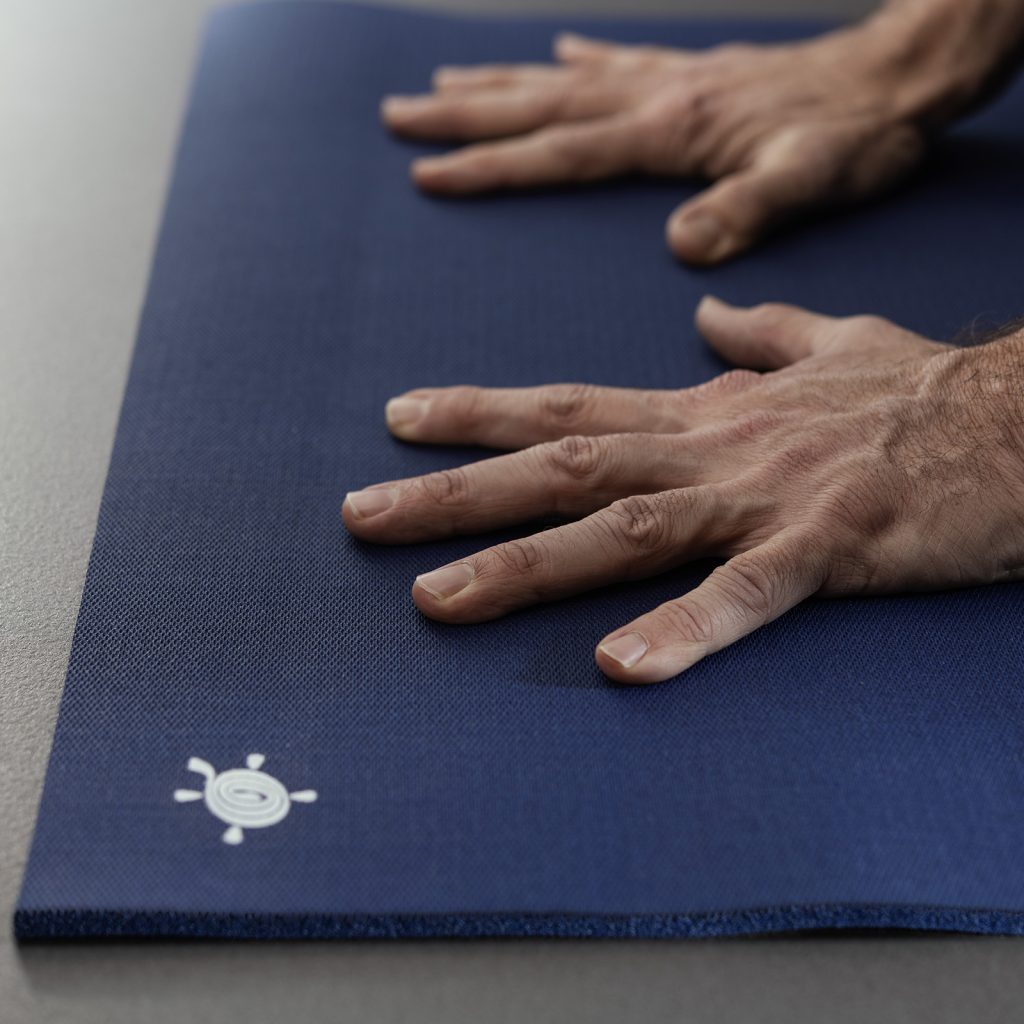What is a yoga mat made of?
Finding your ideal yoga mat can be quite a challenge. In addition to determining the length, width, and thickness, the choice of material will play a crucial role in the yoga journey you’re about to embark on with your mat. So, which material should you choose for your yoga mat? In this blog, we’d like to tell you a bit more about it.
What materials are yoga mats made from?
Nowadays, yoga mats are available in PVC (polyvinyl chloride), natural & synthetic rubber, TPE (thermoplastic elastomers), EVA (Ethylene Vinyl Acetate), PU (polyurethane), cork, wool, cotton, and in combinations such as cork/rubber or microfiber fabric/rubber. The variety of yoga mats on the market can be overwhelming, making it challenging for yogis to make the right choice.
PVC, TPE, EVA, and PU are all commonly used polymers for producing the flexible and soft foam used in yoga mats. For years, specialized blogs have debated the drawbacks of plastic yoga mats, including their environmental impact and the presence of toxic chemicals. These blogs often contain inaccuracies or half-truths. KURMA is convinced that OEKO-TEX® Standard 100 certification is the only way to ensure the absolute safety of mats, both during their use and at the end of their lifecycle.
The OEKO-TEX® Standard 100 criteria list includes approximately 100 annually updated test parameters for harmful substances, including AZO, DOP, phthalates, Bisphenol-A (BPA), lead, and dioxins (see the complete list here).
Rubber, PVC, PU or TPE?
The most common materials are natural rubber, polyurethane (PU), polyvinyl chloride (PVC), and thermoplastic elastomer (TPE). Each type of material has its own unique characteristics that can influence your yoga practice experience.
(Natural) Rubber Yoga Mat
Many brands position their rubber yoga mats as the most environmentally friendly choice on the market, often driven by the claim that they are made solely from natural rubber, also known as latex. However, it is important to note that the processing of latex into a flexible yoga mat still involves the use of chemicals and synthetic rubber.
A rubber yoga mat, such as a KURMA GECO Lite, is characterized by its open-cell surface, making it easy to absorb sweat. This is especially beneficial for yogis who frequently experience sweaty hands during their practice, as a rubber mat offers excellent grip. One drawback of natural rubber is that it is more susceptible to external influences than, for example, a PVC yoga mat. You cannot leave the rubber mat in direct sunlight, as it will begin to oxidize and lighten in color. Additionally, a rubber mat requires regular cleaning.
PU Yoga Mat
PU mats offer maximum dry grip due to the open-cell structure of the surface. During a sweaty or hot yoga practice, a PU mat will absorb a reasonable amount of moisture, which then descends from the top of the mat into the core. Regular cleaning of a PU mat is necessary to remove accumulated sweat and bacteria.
In terms of durability, a PU mat falls between a PVC and a rubber mat. It is important to remember that PU mats also have some drawbacks, such as the need for regular cleaning and lower scratch resistance compared to a PVC mat.
PVC Yoga Mat
Quality PVC foam is very durable and resistant to wear, which is why you’ll find PVC rental mats in most yoga studios. A high-quality PVC yoga mat, such as a KURMA CORE 6.5 mm, can easily last for 10 years or more. Thanks to a closed-cell surface, PVC mats do not absorb moisture and are easy to clean.
PVC mats provide good dry grip when practicing yoga with dry hands and feet. During a sweaty or hot yoga session, moisture will remain on the surface. For your safety, we recommend using a yoga towel to absorb this moisture if you often experience sweaty hands during your practice. In such cases, rubber and PU mats may be a better choice of yoga mat.
TPE Yoga Mat
TPE material is highly suitable for the production of yoga and fitness mats due to its easy and efficient processing capabilities. This explains why the most affordable basic mats are often made of TPE. Moreover, TPE mats are lightweight, recyclable, have low toxicity, and are hypoallergenic.
In terms of dry grip, TPE mats score the lowest compared to rubber, PVC, and PU mats. Furthermore, TPE absorbs perspiration very slowly, causing yogis with sweaty hands to easily slide.
Yoga mats from KURMA; 100% sustainable material
Do you want a sustainable yoga mat that contributes to a better climate? A mat that is produced without toxic substances, is not harmful to health and the environment, and also lasts a long time? KURMA is a leader in sustainability in the yoga world.
KURMA yoga mats are produced in Europe with high-quality raw materials sourced from European suppliers. This way, we can achieve a low CO2 footprint per KURMA mat.
In contrast to what many brands of rubber, TPE, and PU yoga mats claim about the biodegradability of their mats, we at KURMA are not convinced that biodegradability effectively works in a landfill. Instead, we have chosen industrial recycling, which allows us to fully control both the process and the desired output. That’s why all KURMA mats are 100% recyclable.
